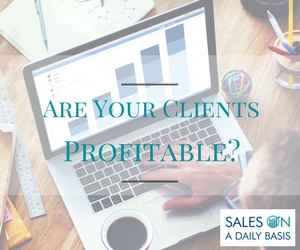MAKE MORE PROFITS
As the business adage goes ‘turnover is vanity but profit is sanity….’FACT.
I have spent a lifetime generating profits – for shareholders of large institutions, for Private Clients, for SME’s. What I have learnt works for corner shops and billion pound retailers. It works whether you sell traditional products, digital products, or services. Online, Offline, Start-Up or mature 2nd or 3rd generation businesses.
I wanted to share with you some of the best, most effective profit drivers I know. Things that I have used and seen work time and time again, because the only thing that you can do to increase profits is to improve the variables that ultimately determine your level of profitability. When you improve these variables you WILL increase profits.
BIG TIP: There are only TWO elements to what you are about to read that are COST related. Yes, it’s vital to obsess about costs and many a profit improvement plan has been based on engineering cost out of a business BUT the true path to incremental profit is to drive the top line and here’s my growth superstars:
1) Lead Generation
There is no one single approach to developing sales leads and every industry will require a slightly different approach, but smart businesses understand that this is something that they need to be doing constantly. You cannot simply make a big push for developing new sales enquiries and then give up on the process once you feel you have expanded your customer base enough. Consistently trying new tactics is the best way to ensure the continued growth of your enquiries, sales and ultimately, your profits. If five out of ten prospects who come into your place of business end up buying from you and you can increase the number of people coming in from ten to 15, you can make more money and increase profits by 50 percent.
2) Lead Conversion
The process by which you convert leads into paying customers. This is the measure of the effectiveness of your sales efforts. If you can increase your conversion rate from one out of ten to two out of ten, you can double your sales and increase profits.
Improving your ability to sell and convert interested prospects into paying customers is one of the most important things you can do. And there is no replacement for ongoing sales training, both for you and for every single person who speaks to customers.
Look at every key result area in your sales process and seek ways to improve a little bit in each area. A small improvement in each key area can lead to an enormous improvement in overall sales results.
3) Number of Transactions
The number of individual sales that you make to each customer that you acquire. By increasing the frequency of purchase by ten percent, you increase your sales and increase profits by the same percentage. Remember that great client who bought your product six months ago?
Or the customer who gave you tons of referrals last year? If you’re like most salespeople, then you have many existing clients like these whom you’ve lost touch with over the past several months — or even years. Many salespeople focus all their energy on lead generation and end up overlooking one of their most valuable assets – Existing customers. But reconnecting with clients after months have gone by isn’t always easy. It can feel awkward and uncomfortable, which is why so many salespeople fail to re-engage them. If you can learn to actively re-engage your existing clients on a regular basis, you’ll stand out from the competition — and find way more business in the process.
4) Size of Transaction
The size of the sale and the profit that you earn from each. You should be continually looking for ways to up-sell each customer so that he or she buys more each time. Upselling doesn’t have to be a dirty word. In fact, it can help you make your customers happier. When used properly, upselling can actually bring you closer to your customers, while bringing you more revenue, better retention and lower churn. Mastering the art of the up sell takes time, practice, and intuition. Although your conversion rate might not be outstanding initially, some diligence and perseverance should optimize your ability and increase your odds for success. Once you get the hang of it, you can expect to increase the average sales from each customer considerably. Besides this, the added value customers receive from up sells can build rapport and lead to repeat sales.
5) Profit Margin per Sale
Profit margin is the gross profit that you make from the sale of each product or service. By continually seeking ways to raise the price or to lower the cost of the product or service without decreasing the quality, you can increase profits per sale.
Every pound you raise a price, if you hold costs constant, flows straight to the bottom line as profit. Every pound you reduce expenses, if you hold sales and revenues constant, also goes straight to the bottom line as net profit. Many businesses never look at their competitor activity, analyse the marketplace and therefore miss out on the opportunity to increase price as they are locked in the past. When was the last time you went to your suppliers and ask for a discount or price reduction? Just by asking the question you will be amazed at how many offer it up!
6) Cost of Customer Acquisition
The amount that you have to pay to acquire each paying customer. You should be continually seeking creative ways to improve your advertising and promotion so that it costs you less to buy each customer. Be all over the numbers. With Google Analytics, CRM systems to name just tow, there is absolutely no reason why you cannot measure your CPA (cost per acquisition) EVERY DAY and optimise your marketing activity accordingly. This will impact and increase profits of your business dramatically.
7) Increasing Customer Referrals
It’s been said that the biggest indicator of a firm’s success is what percentage of its clients are referrals. But why are referrals so valuable? Clients who are referred tend to spend more, be less price-sensitive, have fewer objections and be less risky. But I don’t think you should wait for referrals to come to you sporadically you should instead proactively seek them, no matter what industry you’re in. If you take the time to develop referrals, you’ll get more qualified prospects for the simple fact that people hang out with others like themselves. This cuts the sales cycle to a much shorter timeframe. You will also virtually eliminate objections of the ilk that the prospect doesn’t trust you. Trust is already built in, thanks to your referrer.
8) Premium Products
Do you offer a premium product? In MY EXPERIENCE most businesses, around 5% – 10% of your customers will pay you more for a premium priced product or service. IF you make it available to them. A premium pricing strategy involves setting the price of a product OR service higher than similar products. So do you offer a premium product? I bet I know the answer to that question! The problem is, in most businesses, there is no premium product made available and so that money never gets spent. The money is there, and not everybody wants to buy the cheapest. And if you’re smart, you will work out and then implement what your premium priced product or service can be. All you have to do is make it available and, if you’ve done it correctly, some people will buy it and your profits will go up as a result.
9) The Power of Continuity Pricing Models
With many businesses, on the 1st day of the month, revenue starts at £0. This places an enormous strain at so many different levels. Cash flow, Sales, Lead Generation… all have to be 100% focused to keep the hamster wheel moving. Now I’m not saying there should not be a laser like focus on new sales but creating ongoing revenue streams brings a very important magic to ANY business. Continuity pricing models, are different because they are not a one and done transaction. With continuity pricing models you provide a product or service, and then bill the customer, either monthly, quarterly, or yearly until the customer tells you to stop. By implementing continuity pricing models it allows you to have predictable revenue month after month that increases over time.
10) Overcome objections effectively
Every prospect you speak to has sales objections, or reasons they’re hesitant to buy your product. Why are sales objections unavoidable? Because if the buyer didn’t have reservations about your solution’s price, value, relevance to their situation, or their purchasing ability, they would have already bought it. To be successful, you must learn how to both discover and resolve these objections. Objections are an inevitable part of sales. Some are legitimate reasons to disqualify, while others are simply an attempt to brush you off. But as long as you’re familiar with common objections and equipped to answer them, you’ll be able to distinguish between prospects who have the potential to be good customers and prospects with whom you need to part ways. Your profits will go up as a result.
…and finally Focus and intensity
Focus—have you noticed that the ability to stay focused is becoming very rare? People can’t even watch a TV channel without changing channels. They can’t stay for one minute in quiet thought without scrolling through their smartphones. We easily become distracted even by the smallest of things. Likewise in business, we can become short-sighted – chasing after every shiny object that comes along. Don’t fall into this trap. Keep your eyes on the main plan and keep the entire team focused on what really matters. Identify and obsess about the HIGH VALUE TASKS – those that are really going to shift the dial.
Intensity—when you purposely direct your intensity to things that matter and give unimportant things a wide berth, your momentum grows. Intensity and passions are two of the hallmarks of maintaining momentum in business. If you pursue your goals with great intensity, you become unstoppable. The reason you see athletes do magical things in business or why politicians seem to ooze with unending enthusiasm is because they are intense; they are passionate about what they do and they don’t get distracted by what people think. Business is the same.
The key to creating unstoppable momentum is to remain focused and intense for a long, long time.
Show me an entrepreneur who can stay focused with intensity for a whole year and I will show you an unstoppable person, who’s success and ultimately profits are going to increase exponentially.
Here are the 6 Latest Blogs Posts About Make More Profits

COVID-19, The Crisis, Cash and You
Pete Richardson has worked as a national newspaper journalist and PR specialist so has helped cover and manage the odd crisis. Covid-19 is a massive challenge for society and fundamentally changing lives, but there are ways to cope as business owners and senior...

How Realistic Are Your SMART Goals?
SMART goals – we have all come across them at some point in our lives. This well-known acronym has been considered a staple guideline in business for decades, helping business owners to break down their goals in a way that makes them easier to achieve. Conceptualised...

Get Support!
Sometimes being the boss is a lonely business. On one hand the good news is that you’re in charge. But the bad news is you are in charge. Whether you are a sole operator or have a team of hundreds the buck stops with you. And this means you are expected to know all...

What is your time worth?
Time: It’s a funny thing in the world of sales, isn’t it? Ask anyone in business and they’ll say there’s often not enough of it, and how fast it moves depends on the daily tasks ahead. That’s why we have developed the Sales On A Daily Basis 5 Week Hustle. If you’ve...

Kick Start 2020 With These Five Business Tips
Now that we are nearing the end of 2019 and about to start a new decade, it’s important to schedule some time to reflect on the last 12 months and start to think about what 2020 might have in store. Identifying areas you’d like to change within your business, or...

Are Your Clients Profitable?
How many of your clients are profitable? You might think they all are, especially if your overall business is consistently in profit. But when you break it down, you will more than likely discover that a significant portion of your client base are not as profitable as...
